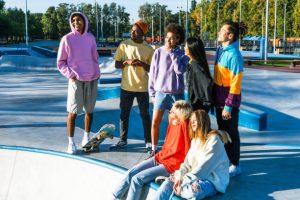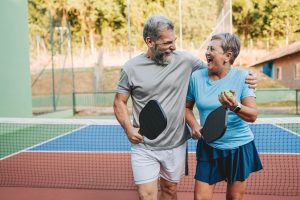6
Section One: The Fundamentals
A) Keywords
Exercise 1:
Provide a brief definition of one of the padlet keywords for this week.
| Feminization of ageing – This defines the demographic trend that the population of older generations is increasingly more women as they have a longer average life expectancy compared to men. However, older women are at higher risk for poverty with lower incomes and pension plans, face health issues and disability, and are often expected to be unpaid caregivers for grandchildren. Feminization of ageing can also define the concept of aging women being less valued with high societal standards. Women are portrayed as perfect and they are not allowed to have flaws. They are also often sexualized where aging women do not fit the narrative and expectations that society has for women.
|
B) The Social Significance of Aging in Sport
Exercise 2: Notebook Prompt
How is old age popularly represented today? Find an image online that you think exemplifies one defining attitude towards old age and paste in your notebook below with a brief explanation of what this image means to you.
| Older people are often portrayed as “sweet and harmless” in many narratives. They are often viewed as irrelevant and not taken seriously – especially older women, whose opinions are not always valid to society. The “sweet old grandma” is a popular narrative amongst media seen in TV shows, movies and social media. Grandma Droniak on TikTok gained a following after her “fit checks” went viral with many people thinking she was “cute” or “sweet” (to be fair she is!). But also broke stereotypes about women her age by further gaining a platform with people seeing her funny and sassy side, sharing videos about “boy problems” often relating to many younger people.
|
Exercise 4: Notebook Prompt
Who are the groups less likely to have extensive opportunities to take part in sports, according to Pike? How does privilege factor into aging and sport? (200 words max)
| According to the Pike article, groups less likely to have extensive opportunities for sports are those of older age as well as those with disabilities. Focusing on restricted access to sports of older age even though there is an increase of encouragement for older people to engage in exercise is often defined by the anti-aging agenda. Seniors are encouraged to stay active but those who do not fit the active or healthy senior narratives do not always have access to sports as they are expected to be fairly active when playing. There should be more accessibility to clubs or leagues that focus on sports and active activities for seniors who are not necessarily “fit” but want to stay active and healthy. There is also the other side of the spectrum that some seniors are looking for sports that are more competitive with actual competitions and not just recreational. We are seeing an increase in seniors participating in sports with the popularity of low-impact sports like pickleball and curling. As well as tournaments like the 55+ games encouraging seniors to stay active. Privilege often factors into accessible to sports for seniors. This includes economic privilege as they have the ability to afford memberships to gyms helping them stay fit that may also offer certain sports clubs. Health can be a privilege in itself too with some seniors having better access to certain health care contributing to them staying fit and healthy and their ability to participate in sports.
|
Exercise 5: Padlet Discussion
Why do you think age discrimination is “reported more than any form of prejudice” with older people presented as a threat to social values and interests? Feel welcome to use video in your responses. Paste your comments (or transcript of your video) below!
| Age discrimination gets reported more as it is not taken as seriously as other forms of discrimination with it often going unaddressed. Society often values younger generations as they have an immense amount of promise and can be adaptable to new skills, especially becoming winning athletes. Older people are more viewed as “behind the times” whereas in professional roles, can be viewed as not being as worthy and unproductive. Many also do not take the time to teach older generations new skills whereas resources are geared towards teaching younger generations new skills. Many seniors are willing to learn new skills, whether that be with technology or maybe playing a new sport, but do not often receive the support. Society can also view seniors as dependent when they need additional health care or support. This can be seen as a negative against economic efficiency as people view it as a waste of time, resources or energy leading to many seniors not receiving the support they need.
|
B) Older Women and Sport
Exercise 6: Notebook Prompt
What differences do you see in these ads? Which one is more inclusive? How is age represented or not represented in each? Answer these questions in your notebook.
| The main difference between the ads is that in the first ad both women and men were involved whereas the second ad only featured women. I would say that both ads are inclusive in different ways with the first ad focusing on many social justice issues including race, sexuality, and gender. It also featured people with disabilities as well as people of different skill levels within the sport. The second ad focused on women and showed various women of different races, ages, sizes and capabilities. The second ad included more age diversity with athletes whereas the first ad really only showed young athletes. Although the first ad did include women of different ages, I did not notice any that were visible of senior age. Overall, both ads had strong messages about inclusivity and breaking barriers, however, they also demonstrated how older people are not very often represented in the sporting community.
|
Exercise 7: Notebook Prompt
In her article, “Assessing the sociology of sport: On age and ability,” Elizabeth Pike references a “trend towards a ‘feminisation of ageing’, with many women living longer than men” (573). Do you agree that aging has been “feminized” in this way? How? Answer these questions in your notebook.
| Elizabeth Pike’s point about the feminization of aging is accurate with current demographics with women statistically living longer than men. There is a growing population of senior women especially those over 75. Aging has also been feminized in a way that older women are more vulnerable to situations economically and are generally more stereotyped. Due to the growing population of older women, their experiences are more central to the “aging experience” for the general population. Women also face more scrutiny for aging than men, as women have high societal standards. This within itself is the feminization of aging as women are expected to maintain their beauty and youthfulness, instead of accepting the beauty that is aging.
|
Section Three: Module Mini Assignment
| The article discusses how sociological research on sports needs to additionally focus on age and ability. Sports often focuses on young aspiring athletes or professional athletes in their prime including the social justice issues that usually surround that demographic. Sports played by seniors is on the rise with many increasingly participating in sports for fun as well as to stay healthy and active. There is additionally a rapid growth of an aging population, and more research needs to be dedicated to understating sports and capability as we age. Pickleball is rising in popularity amongst seniors due to its low-impact nature and social aspects. However, there have been controversies surrounding the sport of pickleball as the sport is very nosey disrupting neighbours and communities. The Toronto Star article “Neighbour claims pickleball noise is ‘torture,’ takes town and club to court”, discusses how a particular resident in Niagra-on-the-lake, claims the noisiness of the sport has affected her mental health, having no option but to take the issue to court as her complaints are not taken seriously. Another article noted how there are Facebook groups called “Pickleball Noise Relief Groups”, as many struggles with the noise the sport causes. These issues with the noise of the sport are not taken seriously as people believe these people are just haters of the sport wanting to end the game together which is not necessarily true. Ageism also plays a factor in the “seriousness” of the issue as many pickleball players are seniors who are rarely treated as serious athletes where they are often stereotyped as “sweet” or “adorable”. The comparison can be made to the rising popularity of skateboarding in the 2000s, increasing skateparks being built many of which were later shut down due to noise complaints. Noise complaints in relation to skate parks were taken more seriously by cities and communities as it is a popular sport amongst younger people. Youths and adolescents are often overlooked or taken advantage of by older generations, as their needs are dismissed and they are more passive making them easier to ignore.
People playing pickleball are often portrayed as happy older adults, while skateboarders are typically portrayed as groups of teenagers hanging out or socializing, an image that can create negative perceptions among older generations.
Flamm, J. (2024, July 24). It’s Time To Admit We Have a Problem Pickleballers. The Dink Pickleball. https://www.thedinkpickleball.com/its-time-to-admit-we-have-a-problem-pickleballers/ Saunders, E. (2022, April 21). Neighbour claims pickleball noise is “torture,” takes town and club to court. Toronto Star. https://www.thestar.com/news/canada/neighbour-claims-pickleball-noise-is-torture-takes-town-and-club-to-court/article_5f28b611-98bf-52cd-b495-b60aea57834a.html |




